
The Southern Pacific was an American Class I railroad network that existed from 1865 to 1996 and operated largely in the Western United States. The system was operated by various companies under the names Southern Pacific Railroad, Southern Pacific Company and Southern Pacific Transportation Company.

The California Zephyr was a passenger train that ran between Chicago, Illinois, and Oakland, California, via Omaha, Denver, Salt Lake City, Winnemucca, Oroville and Pleasanton in the United States. It was operated by the Chicago, Burlington & Quincy (CB&Q), Denver & Rio Grande Western (D&RGW) and Western Pacific (WP) railroads, all of which dubbed it "the most talked about train in America" on March 19, 1949, with the first departure the following day. The train was scheduled to pass through the most spectacular scenery on its route in the daylight. The original train ceased operation in 1970, though the D&RGW continued to operate its own passenger service, the Rio Grande Zephyr, between Salt Lake City and Denver, using the original equipment until 1983. In 1983 a second iteration of the California Zephyr, an Amtrak service, was formed. The current version of the California Zephyr operates partially over the route of the original Zephyr and partially over the route of its former rival, the City of San Francisco.

The Crescent is a daily long-distance passenger train operated by Amtrak between New York City and New Orleans. The 1,377-mile (2,216 km) route connects the Northeast to the Gulf Coast via the Appalachian Piedmont, with major stops in Charlotte, North Carolina; Atlanta, Georgia; and Birmingham, Alabama.

The Amtrak Cascades is a passenger train route in the Pacific Northwest, operated by Amtrak in partnership with the U.S. states of Washington and Oregon. It is named after the Cascade mountain range that the route parallels. The 467-mile (752 km) corridor runs from Vancouver, British Columbia, through Seattle, Washington, and Portland, Oregon, to Eugene, Oregon.

The Coast Starlight is a long-distance passenger train operated by Amtrak on the West Coast of the United States between Seattle and Los Angeles via Portland and the San Francisco Bay Area. The train, which has operated continuously since Amtrak's formation in 1971, was the first to offer direct service between Seattle and Los Angeles. Its name is a combination of two prior Southern Pacific (SP) trains, the Coast Daylight and the Starlight.
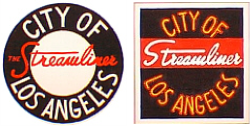
The City of Los Angeles was a streamlined passenger train between Chicago, Illinois, and Los Angeles, California via Omaha, Nebraska, and Ogden, Utah. Between Omaha and Los Angeles it ran on the Union Pacific Railroad; east of Omaha it ran on the Chicago and North Western Railway until October 1955 and on the Milwaukee Road thereafter. The train had number 103 westbound and number 104 eastbound.
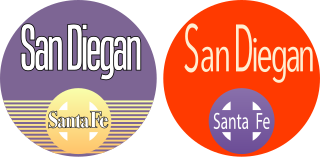
The San Diegan was one of the named passenger trains of the Atchison, Topeka and Santa Fe Railway, and a “workhorse” of the railroad. Its 126-mile (203-kilometer) route ran from Los Angeles, California south to San Diego. It was assigned train Nos. 70–79.

A dome car is a type of railway passenger car that has a glass dome on the top of the car where passengers can ride and see in all directions around the train. It also can include features of a coach, lounge car, dining car, sleeping car or observation. Beginning in 1945, dome cars were primarily used in the United States and Canada, though a small number were constructed in Europe for Trans Europ Express service.

The North Coast Limited was a named passenger train operated by the Northern Pacific Railway between Chicago and Seattle via Bismarck, North Dakota. It started on April 29, 1900, and continued as a Burlington Northern Railroad train after the merger on March 2, 1970 with Great Northern Railway and the Chicago, Burlington and Quincy Railroad. The next year, it ceased operations after the trains which left their originating stations on April 30, 1971, the day before Amtrak began service, arrived at their destinations.
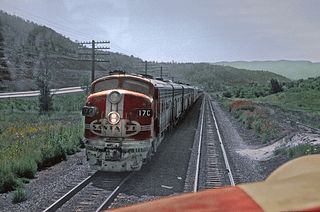
The Chief was an American long-distance named passenger train of the Atchison, Topeka and Santa Fe Railway that ran between Chicago, Illinois and Los Angeles, California. The Santa Fe initiated the Chief in 1926 to supplement the California Limited. In 1936 the Super Chief was introduced, after the Super Chief was relaunched in 1948 with daily departures from LA and Chicago it gradually eclipsed the Chief as the standard bearer of the Santa Fe because of its timetable oriented to the Raton Pass transit. For some the Chief and San Francisco Chief as deluxe integrated trains with both Pullman sleepers and fully reclining coach seating with all facilities; lounges and pleasure domes, available to all passengers were at least equal flagships better suited to the business and executive market. From the mid 1960s the super Chief was only a small entirely separate section of the El Capitan seated vista train, the El Capitan passengers having no access to the Super Chiefs expensive eateries and bars which selling point was exclusion and service. The Chief was discontinued in 1968 due to high operating costs, competition from airlines, and the loss of Postal Office contracts.

The Coast Daylight, originally known as the Daylight Limited, was a passenger train on the Southern Pacific Railroad (SP) between Los Angeles and San Francisco, California, via SP's Coast Line. It was advertised as the "most beautiful passenger train in the world," carrying a particular red, orange, and black color scheme. The train operated from 1937 until 1974, being retained by Amtrak in 1971. Amtrak merged it with the Coast Starlight in 1974.

The Golden State was a named passenger train between Chicago and Los Angeles from 1902–1968 on the Chicago, Rock Island and Pacific Railroad and the Southern Pacific Company (SP) and predecessors. It was named for California, the “Golden State”.

The City of San Francisco was a streamlined through passenger train which ran from 1936 to 1971 on the Overland Route between Chicago, Illinois and Oakland, California, with a ferry connection on to San Francisco. It was owned and operated jointly by the Chicago and North Western Railway (1936–55), Chicago, Milwaukee, St. Paul and Pacific Railroad (1955–71), the Union Pacific Railroad, and the Southern Pacific Railroad. It provided premium extra fare service from Chicago to San Francisco when introduced in 1936 with a running time of 39 hours and 45 minutes each way.
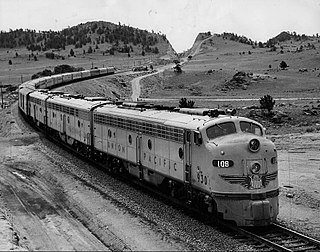
The Challengers were named passenger trains on the Union Pacific Railroad and the Chicago and North Western Railway. The economy service ran between Chicago, Illinois, and the West Coast of the United States. The trains had full Pullman service and coach seating and were an attempt to draw Depression-Era riders back to the rails. Food service was advertised as "three meals for under a dollar a day."

The Lark was an overnight passenger train of the Southern Pacific Company on the 470-mile (760 km) run between San Francisco and Los Angeles. It became a streamliner in 1941 and was discontinued on April 8, 1968. The Lark ran along the same route as the Coast Daylight and was often pulled by a locomotive wearing the famous Daylight paint scheme of orange, red, and black.

The Cascade was a passenger train of the Southern Pacific on its route between Oakland, California, and Portland, Oregon, with a sleeping car to Seattle, Washington. The Southern Pacific started the train on April 17, 1927, soon after the opening of its Cascade Line between Black Butte, California, and Springfield, Oregon.
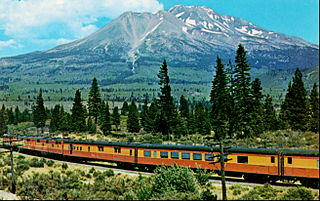
The Shasta Daylight was a Southern Pacific Railroad passenger train between Oakland Pier in Oakland, California, and Portland, Oregon. It started on July 10, 1949, and was SP's third "Daylight" streamliner; it had a fast 15-hour-30-minute schedule in either direction for the 713-mile (1,147 km) trip through some of the most beautiful mountain scenery of any train in North America. The Shasta Daylight replaced heavyweight trains on the same route that had taken nearly a day and night to complete the run. The Shasta Daylight was the first diesel powered Daylight and the only Daylight to run beyond California. The scenic route of the Shasta Daylight passed its namesake Mount Shasta in daylight hours.

The Overland Limited was an American named passenger train which for much of its history was jointly operated by three railroads on the Overland Route between San Francisco and Chicago. The Southern Pacific Railroad handled the train west of Ogden, Utah, the Union Pacific Railroad between Ogden and Omaha, Nebraska/Council Bluffs, Iowa, and east of the Missouri River to Chicago it was operated by the Chicago and North Western Railway as well as, for a few years starting in 1955, by the Chicago, Milwaukee, St. Paul and Pacific Railroad.

The Pacific Limited was an American named passenger train which from 1913 to 1947 was jointly operated by three railroads on the Overland Route between Portland, Oregon, Oakland, California, Los Angeles, California and Chicago. The Southern Pacific Railroad (SP) handled the train west of Ogden, Utah, the Union Pacific Railroad (UP) between Ogden and Omaha, Nebraska, and east of the Missouri River to Chicago it was operated at different times by the Chicago, Milwaukee, St. Paul and Pacific Railroad (MILW) or the Chicago and North Western Railway (CNW). While the train was advertised as going to San Francisco, it actually went to Oakland. Passengers completed the trip by ferry from Oakland Pier to the San Francisco Ferry Building at the foot of Market Street in San Francisco.
The Union Pacific heritage fleet includes commemorative and historic equipment owned by the Union Pacific Railroad. The fleet currently consists of two historic steam locomotives, three historic diesel locomotives, seventeen modern diesel locomotives in historic or commemorative paint schemes and nearly four dozen passenger cars used on office car specials and excursion trains.



















